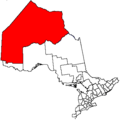Wapekeka 2 | |
|---|---|
| Wapekeka Indian Reserve No. 2 | |
| Coordinates: 53°50′N89°34′W / 53.833°N 89.567°W | |
| Country | |
| Province | |
| District | Kenora |
| First Nation | Wapekeka |
| Area | |
| • Land | 25.12 km2 (9.70 sq mi) |
| Population (2016) [1] | |
• Total | 440 |
| • Density | 17.5/km2 (45/sq mi) |
| Website | www.wapekeka.ca |
Wapekeka 2 is an Oji-Cree First Nation reserve in Kenora District, and is one of the reserves of the Wapekeka First Nation.

